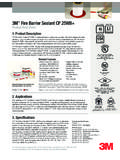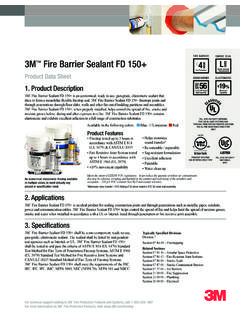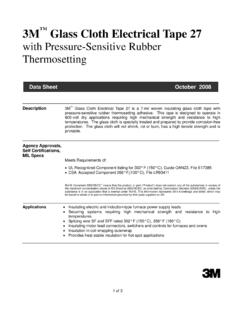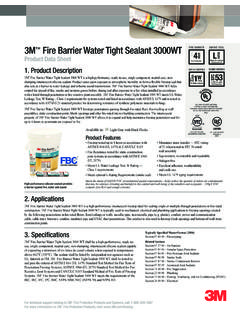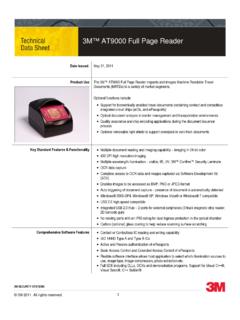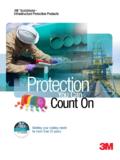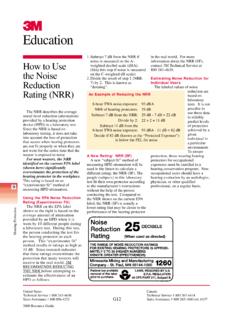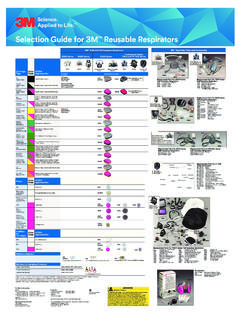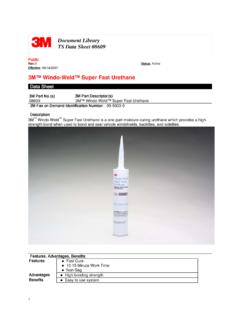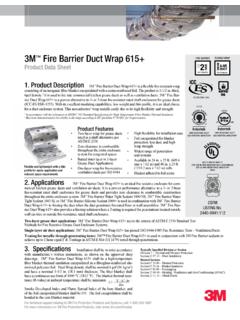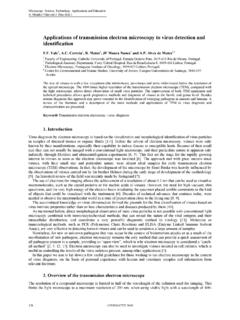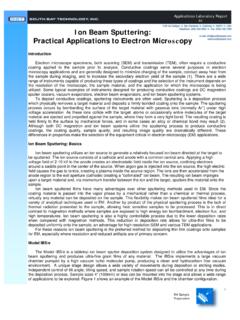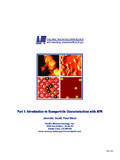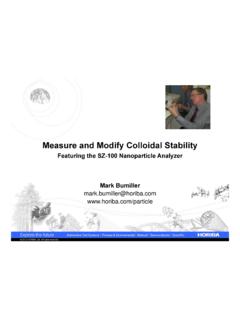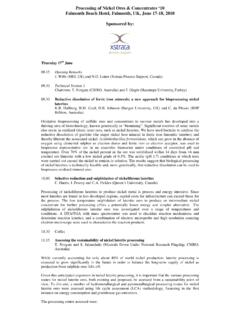Transcription of Adper™ Single Bond 2 Adhesive
1 Adper Single bond 2 AdhesiveAdpertechnical product profileTM23 Table of ContentsIntroduction ..5 Indications for Use ..7 Background ..8 Physical Properties ..11 Independent Investigations ..13 Technique Guides ..14 Management of Post-operative Sensitivity ..18 Instructions For Use ..19 References ..2645 IntroductionProduct DescriptionAdper Single bond 2 Adhesive , based on the clinically proven Adper Single bond Adhesive isa total etch, visible-light activated dental bonding agent incorporating 10 percent by weight of5nm diameter silica filler. As with the original Adper Single bond Adhesive , Adper Single bond 2adhesive is indicated for direct light-cured restorative material as well as for the treatment of cervi-cal sensitivity. Adper Single bond 2 Adhesive may also be used for bonding laboratory fabricatedcomposite or porcelain veneers when used with RelyX Veneer Cement and for bonding amalgamand other indirect applications when used with RelyX ARC Adhesive resin cement.
2 Adper Single bond 2 Adhesive is available in either a vial or unit dose. The vial incorporates a pinch & flip cap design that minimizes the messiness associated with typical threaded the standard black, opaque vial used by manufacturers to shield the photoinitiator from allambient light, the Adper Single bond 2 vial was designed to shield predominantly the visible lightabsorbed by the photoinitiator. This design allows for a unique translucent vial that permits visualinspection of the 1. Selective light absorption of Adper Single bond 2 Single bond 2 Adhesive is also offered in a convenient and hygienic unit dose delivery sys-tem. Simply pressing the Single chambered foil package advances Adhesive to the self-containedapplicator. Adper Single bond 2 Adhesive Unit Dose Delivery SystemBBBBBBBBBBBBBBBBBBBBBBBBBBBBBBBBBB BBBBBBB888888888888888888888888888888888 8888888820030040050060070080090010000510 152025303540% Light TransmissionWavelengths, nanometersBPhotoinitiator Absorbance8 New Orange VialSource: 3M ESPE Laboratorytest data6 CompositionAdper Single bond 2 AdhesiveWith the exception of the silica nanofiller, Adper Single bond 2 Adhesive contains the same com-ponents as the original Adper Single bond Adhesive : BisGMA, HEMA, dimethacrylates, ethanol,water, a novel photoinitiator system and a methacrylate functional copolymer of polyacrylic andpolyitaconic acids (see structure in Figure 2) first introduced in Vitrebond Glass Ionomerliner/base and also utilized in Adper Scotchbond Multi-Purpose Adhesive , RelyX LutingCement and Vitremer Core/Restorative.
3 Incorporation of the polyalkenoic acid into the Adper Scotchbond Multi-Purpose primer has been shown to aid in resisting the detrimental effect ofmoisture in an elevated relative humidity environment (Fundingsland et al. 1992). The patentedphotoinitiator system allows for a fast 10-second light cure. The cure time may be reduced to 5seconds when using the Elipar FreeLight 2 LED Curing Light. Figure 2. Vitrebond polyalkenoic acid copolymerNanotechnology in Adper Single bond 2 AdhesiveAdper Single bond 2 Adhesive incorporates 10% by weight of 5 nanometer-diameter spherical sil-ica particles. These silane treated particles are incorporated into the Adhesive through a processthat prevents agglomeration. As discrete particles, their extremely small size keeps them in col-loidal suspension. This means you never have to shake Adper Single bond 2 Adhesive prior tousing.
4 In contrast, larger filler particles incorporated into some adhesives are at risk of settling outof solution. Such adhesives require routine shaking before 3 demonstrates this difference in suspen-sion stability between the nanoparticles in AdperSingle bond 2 Adhesive and the much larger parti-cles averaging microns in diameter inOptibond Solo Plus Adhesive (filled 15% byweight). Approximately four grams of each Adhesive wasdispensed into separate glass vials and tightlycapped: Optibond Solo Plus Adhesive was vigor-ously shaken for 10 seconds prior to one week of observation, a phase separa-tion in Optibond Solo Plus Adhesive becameevident. This separation progressed to thatshown in Figure 3, which shows Optibond SoloPlus Adhesive after storing undisturbed forapproximately 4 months. Conversely, the vialcontaining Adper Single bond 2 adhesiveshows no separation after storing undisturbedfor approximately 10 3.
5 (l) Nanofiller in Adper SingleBond 2 Adhesive remains in solution;(r) filler in Optibond Solo Plus does ESPE Scotchbond EtchantPrior to applying Adper Single bond 2 adhe-sive, enamel and dentin require a separate etchwith phosphoric acid. Scotchbond etchantsuperficially demineralizes the enamel anddentin in preparation for bonding. The etchantis 35% phosphoric acid by weight. Use of anetchant is critical on both enamel and dentinalsurfaces. The phosphoric acid etchant has a pHof approximately The phosphoric acid geletchant is thickened to a high viscosity withfumed silica and a water soluble surfactant. The surfactant enables the etchant to be rinsed away more easily. 3M ESPE RelyX Ceramic PrimerRelyX Ceramic Primer is a prehydrolyzed, Single -phase silanespecifically designed to enhance the bond to ceramic results have also suggested some benefit of application tometals.
6 Previous testing also suggests that RelyX CeramicPrimer has three years of shelf-life stability. The ceramic primeris required for indirect bonding applications such as porcelainveneers, crown and bridge, inlay/onlays and for porcelain for Use3M ESPE Adper Single bond 2 Adhesive is indicated for use in the following types of restorations. Direct light-cured composite/compomer restorations Root surface desensitization Porcelain/composite repair Porcelain veneers (when used with RelyX Veneer Cement) Crown & bridge, inlay/onlay, bonding amalgam (when used with RelyX ARC AdhesiveResin Cement)8 BackgroundModern adhesives for bonding restorative materials to tooth structure encompass a range of strate-gies. Currently, a popular strategy in Adhesive dentistry involves the total etch, Single solutionadhesive (also known as fifth generation Adhesive ).
7 The original Single bond Adhesive , intro-duced in 1997, offered the dental profession the performance of a multi-bottle system in an easy to use, time saving Single bottle system. With the introduction of RelyX ARC Resin Cement in1998, Single bond Adhesive expanded its versatility to include bonding amalgam and cementationof laboratory fabricated restorations. The Single bond Adhesive ease of use philosophy was real-ized with RelyX ARC resin cement as no additional bottles containing accelerants are needed. In2001, a complementary cement, RelyX Veneer Cement, was introduced specifically for use withSingle bond Adhesive , once again, expanding the versatility of this Adhesive . Adper Single bond 2 Adhesive offers all the features and benefits of the clinically proven AdperSingle bond Adhesive and introduces new nanofiller technology and the convenience of a unique unit dose Mechanism Current dental adhesives rely on a micromechanical bond for adhesion to enamel and dentin.
8 With total etch adhesives the mineral phase of enamel and dentin (hydroxyapatite) is superficiallydemineralized by an acidic agent in a separate step prior to application of the Adhesive . The acidused is typically a gelled phosphoric acid with a concentration of approximately 35%. On enamel, acid etching greatly increases the surface area available for bonding. Low viscosity,polymerizable resins penetrate the porosities revealed by the etching procedure forming an inter-locking mechanical bond after curing. These interlocking resin tags can be seen in Figure 4which shows a cross-section of the enamel/ Adhesive bond interface produced with Adper SingleBond 2 Adhesive . Figure 4. Scanning electron photomicrograph of Adper Single bond 2 Adhesive bond to enamel. Enamel has been partially dissolved during microscopy specimen preparation to reveal resin tags penetrating into etched enamel.
9 (image from Patricia Pereira).AdhesiveResin Tags9 Asimilar process involving dissolution of the mineral phase and an interlocking Adhesive layeroccurs when bonding to dentin. A 15 second etch of prepared dentin completely dissolves thesmear layer and removes the mineral phase to a depth of around 5 microns. A collagen, or proteinphase, resistant to acid dissolution is present at the surface after washing off the of the Adhesive into this collagenous phase and its subsequent polymerization providesan interlocking layer commonly referred to as the hybrid layer. The dentinal hybrid layer isrevealed in a scanning electron micrograph in Figure 5 for Adper Single bond 2 5. Scanning electron photomicrograph of Adper Single bond 2 Adhesive bond todentin (image from J. Perdigo & M. Lopes, University of Minnesota).Role of Inorganic Filler in Single Solution, Total-Etch AdhesivesTo ensure optimum penetration of Single solution adhesives into the collagen network, the adhe-sive resins are dissolved in a volatile solvent.
10 After application, the solvent is evaporated with astream of air leaving the Adhesive layer ready for light curing. It has been suggested that the pres-ence of filler in these relatively low viscosity adhesives helps develop a uniform Adhesive film and stabilizes the hybrid layer (Inoue). This theory may be especially significant in instances wherean overly aggressive drying technique is practiced. The filler density in cured films of adhesives was explored by transmission electron microscopy(TEM) at 3M Laboratories. In these images, the electron dense areas (grey to black shaded areas)represent filler. It is readily observed that the cured film of Adper Single bond 2 Adhesive (Figure6) exhibits the greatest filler density of the four, total etch, Single solution adhesives. Of interest isthe relatively low filler density in the cured film of Excite Adhesive (Figure 7) and the lack ofhomogeneity in both filler density and particle size in Optibond Solo Plus Adhesive (Figure 9).
